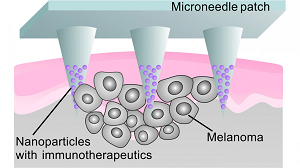 |
| Microneedle patch designed to release nanoparticles to melanoma cells--Courtesy of NC State |
In an effort to more effectively target melanoma cells in the skin, researchers at North Carolina State University have developed a microneedle patch embedded with a nanoparticle immunotherapy treatment.
The team used anti-PD-1 antibodies to prevent the melanoma cells from tricking human T cells. This way, the T cells can effectively attack the cancer cells instead of passing them by. Anti-PD-1 antibodies have been used in this way before, but delivering the treatment to cancer cells in the skin can be challenging.
The patch overcomes the delivery hurdle by injecting the antibodies directly into the shallow part of the skin. Normally, they are injected into the bloodstream, but this is less effective when it comes to this kind of cancer. And, according to the university, it can prevent an overdose.
The microneedles consist of biocompatible hyaluronic acid, and they hold nanoparticles and glucose oxidase--as the glucose oxidase reaches the blood, it converts to an acid, which then breaks down the nanoparticles, releasing the antibodies.
The team published the results of a mouse study in the journal Nano Letters.
"This technique creates a steady, sustained release of antibodies directly into the tumor site; it is an efficient approach with enhanced retention of anti-PD-1 antibodies in the tumor microenvironment," said lead researcher Zhen Gu. "…Because of the sustained and localized release manner, mediated by microneedles, we are able to achieve desirable therapeutic effects with a relatively low dosage, which reduces the risk of auto-immune disorders."
- here's the NC State release